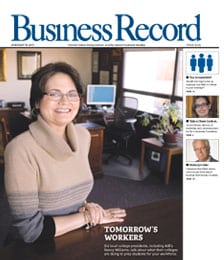TAKING STOCK: Five issues with their own ‘issues’

Dear Mr. Berko:
I want to do some risky investing, so I am considering the purchase of 1,000 shares of each of the following, Calpine, El Paso, Dynegy, AES and Reliant Resources. Please give me your opinion on these issues and a five- to six-year price target for each. Just in case you are wondering, I can afford the risk and would enjoy playing these horses.
R.R. Oklahoma City
Dear R.R.:
I think a 1,000-share purchase of each of those issues could be a real smart and classy speculation. Apparently, you are the type of guy who plays the long shots at the betting window. So, here goes.
El Paso Corp. (EP-$6) gathers, stores, transports, processes and sells natural gas and other energy resources. EP also explores for natural gas and oil, operates energy infrastructure facilities and owns or has an interest in 61,000 miles of pipeline. EP was one of the hottest stocks on Wall Street in 2000 and 2001, when it traded in the mid-$70s before crashing to a low of $3.33 this year. Revenues in 2001 were $57 billion and fell last year to $12 billion and earned $1.30 a share in the process.
This year, EP revenues are expected to decrease again to about $10 billion, but the suits on the Street think EP will earn (depending on the books) between 95 cents and $1.40. Believe it or not, this thing pays a 16-cent dividend. Even though EP has $18 billion in debt, the company has a book value of $16.
EP is followed by 16 suits, six of whom have assigned a “buy” rating while the other 10 tell us to “hold.” This is a great stock if you have a modest death wish. Value Line thinks it could be worth between $16 and $25 within the next four to five years.
Dynegy Inc. (DYN-$2.55) is another Wall Street darling of 2000 and 2001, when shares traded in the $60s. DYN owns and manages 12,000 megawatts of power and markets, gathers and processes natural gas liquids and crude oil.
In its heyday, (2001) it put $42.4 billion in revenues on the books, earning $1.89 a share. In 2002, those revenues fell by 50 percent to $21.5 billion and DYN lost a smidgen over $4 a share. But this year, the suits believe DYN will post $8 billion in sales and possibly earn a nickel a share. In 2004, those suits predict $6.5 billion in revenues and 10 cents a share in earnings.
The company has $4.5 billion in debt but a realistic book value of $6. The suits reckon DYN could be worth about $12 by 2007, with earnings of nearly $1 a share. If you are comfortably sleeping on a bed of hot coals, this stock is right for you.
AES Corp. (AES-$4.10) is a $9.3 billion revenue global power company with ownership interests in 180 generation facilities that produce more than 63,000 megawatts of power. Its plants are located in Argentina, Brazil, Pakistan, China, Kazakhstan and the Dominican Republic. These countries have rather high-risk, unstable economies and I wouldn’t trust a buck to any bank there.
In its halcyon days of 2000-2001, AES traded with gusto in the low $70s before crashing to 90 cents a share. Revenues have continued to grow from $4.6 billion in 2000 to $9.2 billion in 2001 and $9.3 billion in 2002, when AES recorded a first-ever loss of $5.87 a share. But wonder of wonders, the suits believe AES will generate revenues of $9.6 billion this year, post a meager profit of a nickel and possible earnings of 75 cents a share next year.
AES has long-term debt of $18 billion, a $5.25 book value and some suits believe the stock could trade between $12 and $16 a share within the next five years. Well, if you’re comfortable swimming in sewage, you might stay afloat with AES.
Calpine Corp. (CPN-$3.25) has a superb record of revenue growth from $215 million in 1996 and increasing each year to $7.6 billion in 2002. So between 1996 and 2001, CPN’s net income grew like wildfire, endearing itself to the suits who unabashedly pushed the stock to the high $50s in 2000-2001. Depending on who is minding the books, CPN has earned good money every year from 1996 to 2002, when it recorded 70 cents a share in earnings. Believe it or not, the suits reckon that CPN will have 2003 revenues of $8.3 billion and record a profit of 75 cents a share.
CPN builds, acquires and operates power facilities predominantly in the United States and has ownership interest in 88 plants with an aggregate capacity of 26,000 megawatts. The company has long-term debt of $13 billion and a book value of $11 a share. There are 14 suits who follow CPN; five of them rank it a “buy,” eight suits rate it a “hold” and one says, “Sell!” The five-year price consensus puts CPN anywhere between $15 and $20 a share. If you enjoy hang gliding without a parachute, this stock may give you the opportunity to do so.
Reliant Resources (RRI-$4) came public in 2001 at $30 with $36 billion and earnings of $2 a share. It then squeaked to $37 prior to crashing this year to 99 cents a share.
In 2002, according to Standard & Poor’s, RRI generated $11.5 billion in revenues while earning 76 cents a share. In 2003, S&P believes RRI will earn between 83 cents and $1.05 while in 2004, S&P predicts that RRI will earn between 80 cents and $1.13.
RRI provides electrical power to the United States and Europe, owns 19,000 megawatts of power and trades natural gas and other energy-related commodities. RRI has $2 billion in debt, a book value of $17 and the suits believe RRI shares could trade between $16 and $22 within the next five years. If you can handle open-heart surgery without anesthetic, then this issue is for you.
Please address your financial questions to Malcolm Berko, P.O. Box 1416, Boca Raton, FL 33429 or visit his Web site at www.berkoradio.com.






